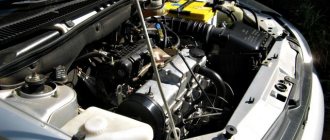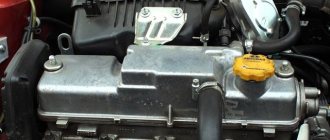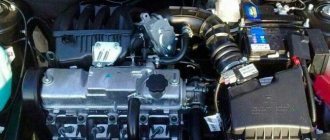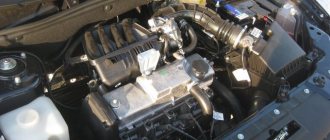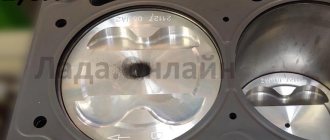The VAZ 11183 engine was designed for the Kalina car. The 21114 engine was taken as the basis, the engine markings changed (1 instead of 2 at the beginning of the internal combustion engine designation), the design of the crankshaft and cylinder head. Changes were necessary to increase the volume to 1.6 liters, and the use of existing parts was necessary to reduce the cost of the power drive.
ICE 11183
Characteristics of motor 11183
The official AvtoVAZ manual contains a description of the parameters of the ICE 11183, according to which the technical characteristics are as follows:
| Manufacturer | AvtoVAZ |
| Engine brand | 11183 |
| Years of production | 2004 – … |
| Volume | 1596 cm3 (1.6 l) |
| Power | 60 kW (82 hp) |
| Torque moment | 120 Nm (at 2700 rpm) |
| Weight | 112 kg |
| Compression ratio | 9,8 |
| Nutrition | injector |
| Motor type | in-line |
| Injection | electronic multipoint |
| Ignition | modular |
| Number of cylinders | 4 |
| Location of the first cylinder | TVE |
| Number of valves on each cylinder | 2 |
| Cylinder head material | aluminum alloy |
| Intake manifold | plastic receiver, electronic throttle |
| An exhaust manifold | combined with catalyst |
| Camshaft | from 21114 |
| Cylinder block material | cast iron |
| Cylinder diameter | 82 |
| Pistons | ordinary |
| Crankshaft | original with increased crank stroke |
| Number of main bearings | 5 |
| Piston stroke | 86 mm |
| Fuel | AI-92-95 |
| Environmental standards | Euro-3 |
| Fuel consumption | highway – 6.2 l/100 km combined cycle 7.6 l/100 km city – 8.8 l/100 km |
| Oil consumption | 0.5 l/1000 km |
| Engine oil for 11183 | 5W-30 and 10W-40 |
| Engine oil volume | 3.5 l |
| Operating temperature | 95° |
| Motor life | declared 150,000 km, real 300,000 km |
| Adjustment of valves | washers between camshaft cams and tappets |
| Cooling system | forced, antifreeze/antifreeze |
| water pump | plastic impeller |
| Candles for 11183 | BPR6ES, A17DVRM |
| Gap between spark plug electrodes | 1.1 mm |
| Timing belt | Gates |
| Cylinder operating order | 1-3-4-2 |
| Air filter | Nitto, Knecht, Fram, WIX, Hengst |
| Oil filter | catalog number 90915-10001 replacement 90915-10003, with check valve |
| Flywheel | from 2110 |
| Valve stem seals | code 90913-02090 inlet light code 90913-02088 exhaust dark |
| Compression | cylinder pressure from 13 bar nominal |
| XX speed | 800 – 850 min-1 |
| Tightening force of threaded connections | spark plug – 18 Nm flywheel – 62 – 87 Nm clutch bolt – 19 Nm bearing cap – 68 Nm (main) and 53 (rod) cylinder head – three stages 29 Nm, 49 Nm and 90° |
The operating manual from the manufacturer includes information on lubricants and coolants. In particular, for these engines it is recommended:
- which oil to choose among the variety of fuel and lubricants manufacturers - ZIK, Total Quartz;
Installation 11183 under the hood
By default, the engine circuit contains a potential of 120 - 160 hp, so upgrading it yourself is possible. The 11183 is unpretentious in operation, the power was added initially by the manufacturer, the compression ratio and compression are standard.
Transmission and suspension VAZ 2110 8 valves injector
Lada 21102 has a built-in five-speed manual transmission (MT).
This box is used on all versions of the 2110 line. It has good noise insulation, the lever stroke is comfortable, and the smoothness of switching is much better than that of Zhiguli and Samara. The body (casing) of the box is made of aluminum alloy. Inside the casing there is a primary (drive) and secondary (driven) shaft. The shafts are combined with the differential and final drive. The five forward gears are equipped with synchronizers, which improve smooth shifting. Gear ratios: 1st gear - 3.636, 2nd - 1.95, 3rd - 1.357, 4th - 0.941, 5th - 0.784. For reverse gear - 3.5. The final drive ratio is 3.7. The operating instructions state that you need to change the transmission oil every 75 thousand km.
Mitigating the impact of the chassis on the body, as well as ensuring stability and smoothness, is carried out by the front and rear suspension of the Lada 2110. An independent design is used on the front axle.
Each wheel has an independent coil spring, inside of which a MacPherson strut is placed. Each strut has its own hydraulic shock absorber. The lower control arms are attached directly to the steering knuckles, and the anti-roll bar is attached to them. Levers help reduce wheel roll (rotate it around the longitudinal axis). When the car makes a turn, the wheel, which is turned “inside the body,” can move away from the axis of rotation. The stabilizer prevents this from happening by twisting. Thus, the front suspension of the Lada 2110 allows you to maintain the stability of the car when cornering. The rear suspension
is a rigid structure, the main element of which is the transverse beam. Since the rear wheels do not rotate, there is no need to provide maneuverability, but rear stability must be at a high level. Therefore, this design was used. The beam consists of trailing arms attached to each wheel and a connector that welds the arms together. The wheels on the rear axle are also equipped with hydraulic shock absorbers to soften impacts. The Lada 2110 is equipped with 175/70 radial tires. Ventilated disc brakes are used on the front wheels, and drum brakes on the rear wheels.
Design Features
After modernizing the 21114 engine taken as a standard, the 11183 engine has the following design nuances:
- “high” cylinder block – height increased by 2.3 mm compared to 2110;
- fasteners - the holes are threaded with M12 standard pitch;
- crankshaft – original, steel, forged, crank radius increased by 2.3 mm;
- cylinder head gasket – thickness 1.2 mm, regular;
- combustion chamber – increased to 26 cm3 due to two-stage milling;
- catcollector - short tubes, round block shape.
Cylinder head 11183
To reduce manufacturing costs, a connecting rod-piston group, a pulley and a crankshaft flywheel from the 2110 engine are installed in the engine. The volumes of the combustion chambers are increased for the engine with the sole purpose of ensuring a compression ratio of 9.6 - 10.0.
The manufacturer does not provide hydraulic compensators in this internal combustion engine, therefore, on the one hand, the use of lower quality oil is allowed. On the other hand, the savings in the operating budget when using cheap lubricants are “eaten up” by the costs of periodically adjusting the valves in a service station, since the manufacturer recommends doing it more often.
The main attachments are driven by their own belts. The design of tensioners (for example, a generator) leaves much to be desired. But the internal combustion engine allows you to increase power in the following ways. Moreover, a reasonable boost does not require major repairs to be carried out more often than the established deadline.
Alternator belt drive
Even without improving the performance, the engine is high-torque and torquey, and produces 200% of the service life declared by the manufacturer. The available repair dimensions of the piston group make it possible to increase the service life, taking into account several overhauls, up to a million kilometers.
Advantages
The VAZ 11183 engine with 8 valve injector has a fairly large number of positive qualities with which many associate its popularity. Owners of cars with this engine note the following advantages:
- The safety margin of the main elements is reserved by the factory. This leads to the fact that the engine, with the right approach, lends itself well to tuning. At the same time, increasing power to 130-150 horsepower does not affect its service life in any way.
- Many people say that the motor has received a much longer resource in comparison with its brothers. This is a completely justified statement, since it began to be assembled with improved quality components, so with the right approach it can go much further.
- The motor is very unpretentious in operation. Many people pay special attention to the lubrication system, since the quality of the oil is practically unimportant, since there are no hydraulic compensators in the design. Of course, you should follow the manufacturer's recommendations.
- Unpretentiousness to fuel. The compression ratio was increased, but to reasonable limits, and the power system was designed in such a way that the engine copes well with low octane gasoline. This is an excellent solution, given the quality of domestic gasoline.
- Timing belt The main advantage of using an 8-valve mechanism is that if the belt breaks, there is no contact between the pistons and the valves. Therefore, you should not be afraid that unplanned repairs may be required.
Advantages and disadvantages
The advantage of the 11183 engine is the cylinder head of the original design. However, it was subsequently further modified into the ICE 11186, adding volume to the combustion chambers. The downside is the generator belt tensioner - the drive is constantly over-tightened, a deflection of 10 mm is not ensured without slipping, so the belt life is reduced and it has to be changed more often. This defect was corrected only in the next version of the motor 11186.
The integrated catalytic collector assembly in the engine was initially unfinished:
- the tubes of the four channels are short;
- flows converge inside the block at almost one point;
- exhausts collide and create opposition to each other;
- the shape of the block did not allow changing the arrangement of the tubes.
Catcollector 11183
When installing the engine on the Lada Granta, the cabin heat exchanger was connected to the thermostat in series. All the coolant passed through it along a small circuit, the response temperature error was 5 degrees instead of the required 2 degrees.
Modifications
As a result of certain modifications, the VAZ-11183-50 engine was obtained, which has no fundamental differences from the main model, but thanks to the modifications it was possible to increase power to 82 horsepower, and torque increased by 12 Nm. The environmental standard has also been increased. The main difference is the installation of an electronic throttle control mechanism, which improved engine controllability, but caused problems with the TPS sensor.
Engineers, through modifications, also coped with a number of persistent problems, for example, now the throttle valve in the engine is no longer dirty. The modernization also resulted in increased engine thrust and improved elasticity. Owners of such engines note that the engine has become less capricious and more reliable, but at the same time fuel consumption has increased.
What cars was it used in?
The manufacturer AvtoVAZ used engine 11183 to equip several car models:
- Lada Kalina – station wagon, sedan, hatchback;
- Lada Kalina II – second generation in similar bodies;
- Lada Granta – sedan, hatchback;
- 21101 – four-door sedan;
- 21112 – five-door station wagon;
- 21121 – short five-door hatchback;
- 2113 (since 2011) – three-door hatchback;
- 2114 (2006 – 2013) – five-door hatchback;
- 2115 Lada Samara-2 (2007 – 2012) – compact sedan.
Lada Granta liftback
Improved engine characteristics ensured the demand for cars of a similar configuration.
J20A engine tuning
Atmo
Let's consider the potential of the 21116 8V engine without replacing the cylinder head with a 16 valve (The 126 16V engine and its modifications are mentioned in a separate article). The first stage, already familiar to us from tuning the 21114 engine, is replacing the camshaft with a Nuzhdin 10.93, installing a split gear, and adjusting the phases. We hang a receiver on top, a 54 mm damper and a 4-2-1 spider exhaust with this kit the engine power will be about 100 hp. With additional modifications and milling of the cylinder head, as well as the intake manifold, we will get about 120 hp.
Compressor
Another method of obtaining similar output from a 116 engine is to install an RK-23-1 compressor with a pressure of 0.5 bar on the piston drain. With a need shaft of 10.63 or 10.42 the result will be better. The well-known video clearly explains everything that is required for the successful implementation of a project based on 2113; all this can be easily recreated on Grant, Kalina, Priora and other cars.
Attention MAT (18+)
The 8-valve head allows you to increase the power above 120 hp, but at the same time the costs of repairing the VAZ 21116 engine will also rise. The potential can be significantly increased by installing a 16-valve cylinder head, with a receiver, damper and exhaust of the same 120 hp. we get it easily and without loss of resource.
Turbo
The best option, when installing a turbine, would be to switch to 16 valves (this is done in order to increase the efficiency of the engine) and continue tuning the priors according to the principle of turbocharging. If you want to build a rare example - an 8-valve turbo, you need to take into account that 8V is extremely unstable to detonation when supercharged. So, to build you will need Niva pistons on 121 connecting rods from 2110, Priora gasket, shafts for turbo (STI-2.1 phase 280 lift 11.4, STI-3 11.7 phase 288 or Nuzhdin 11.8 phase 286), BOSCH 360cc injectors, blow-off, damper 54mm, DBP+DTV, turbine from Volkswagen 1.8T for lower location. All this is configured online, blows 1 bar and produces about 170-180 hp. There are ready-made solutions, kits based on Garett 17, they can easily inflate you to 0.5 bar and the power will jump to +\- 130 hp. All this is done with any 8-valve engine for front-wheel drive VAZs.
ENGINE RATING: 3+
Maintenance
According to AvtoVAZ recommendations, the 11183 engine must be serviced according to the regulations:
| Maintenance object | Time (month) or mileage (10,000 km), whichever comes first |
| Timing drive | 36/ 1 |
| Battery | 12/2 |
| Valve clearance | 24/2 |
| Crankcase ventilation | 24/2 |
| Belts that drive attachments | 24/2 |
| Fuel line and tank cap | 24/2 |
| Engine oil | 12/1 |
| Oil filter | 12/1 |
| Air filter | 12 – 24/4 |
| Fuel filter | 48/4 |
| Heating/cooling circuits | 24/4 |
| coolant | 24/4 |
| Oxygen sensor | 10 |
| Spark plug | 12 – 24/2 |
| Exhaust manifold | 12/1 |
By default, the cooling system has a volume of 7.8 liters. Red Felix Carbox 40 antifreeze is usually poured on the conveyor. Replacement is made with any coolant, taking into account the temperature range of 85 degrees. Since the internal combustion engine device is quite simple, the maintenance operation can be performed on your own.
Maintenance
The VAZ model 11183 engine will operate normally and for a long time only if it is properly maintained. First of all, every 45 thousand kilometers it is necessary to replace the timing belt. It is also recommended to adjust the valves along with it.
Don't forget about changing the oil either. Despite the manufacturer's recommendations, in practice it turns out that the engine will function longer and better if you change the lubricant every 15 thousand kilometers. Along with it, the filter element also needs to be replaced.
Malfunctions: causes, elimination
If the timing belt of the drive breaks, the 11183 motor does not bend the valve, but it has the following typical breakdowns:
| Floating speed | 1) malfunction of the ignition module 2) gasket breakdown 3) valve burnout 4) failure of the TPS sensor | 1) module replacement 2) installing a new gasket 3) valve replacement 4) repair or replacement of the throttle position sensor |
| Extraneous noise | 1) misadjustment of valve clearances 2) piston wear 3)bearing wear 4) production of liners | 1)adjustment with valve gaskets 2) replacement of pistons, rings 3)replacement of bearings 4) use of new liners |
| Alternator belt break | excessive tension, manufacturing defect | Regular check, replacement as necessary |
Since a feature of the ICE 11183 is a well-thought-out design of valves and pistons, overhauls in most cases are carried out on time without additional user investment.
TPS sensor for 11183
Timing device VAZ 2110 injector 8 valves
Many people are concerned about the question of whether the valves on the injection engine of the VAZ 2110 bend. No, they don’t
. The 8-valve injector does not suffer from this defect. But this does not mean that you should not monitor the timing belt. Because loosening and subsequent jumping of the belt by a certain number of teeth will lead to inevitable problems. It is worth paying special attention if engine oil gets on the belt; an oiled belt will not last long. Below is a detailed image of the timing diagram of the 8-valve injection engine “tens”. See the photo below.
When replacing the timing belt on a VAZ-2110, it is necessary to clearly align the marks on the camshaft and crankshaft pulleys; without this, the engine will not operate normally. Another important point is that when the tension roller moves to its original state, the marks shift as the belt tension changes. Therefore, carefully check whether the timing marks are clearly aligned before putting on the cover covering the timing belt.
Typical breakdowns
The very first 1.5 liter engine 2114 has disadvantages:
- periodic valve adjustment;
- unreliable injection system;
- loosening the exhaust manifold nuts;
- Leaking gaskets of the fuel pump, distribution sensor of the ignition system.
The next 1.6 liter engine does not cause any particular problems for the owner, with the exception of high vibration and noise loads. The weak point traditionally remains the valves, which have to be constantly adjusted.
Adjustment of valves
The internal combustion engine from Lada Kalina 11183 was installed on the fourteenth model solely to meet Euro-3 standards. It has typical disadvantages for a linear series and is no different.
The first sixteen-valve engine 21124 does not bend the valves, the gaps in which are adjusted by hydraulic pushers. However, the belt needs to be tightened after 15,000 km due to the large number of attachments. The second and last in the line of fourteenth ICE models, ICE 21126, has increased power. In addition to typical malfunctions, if the timing belt breaks, the piston will bend the valve due to insufficient recess depth.
Acquired deficiencies
The crankshaft of the 1.6 engine is quite modern, it is fully counterbalanced, that is, on the extension of each shaft cheek there is a counterweight (eight in total). Imported motors often have only four counterweights. They save.
“Weight loss” is visible everywhere. The thin rod of the connecting rod merges into a smaller lower head. The piston is lightened to the limit. The area where the piston rings are located and two small “tongues” are left, replacing the previous full skirt.
“Weight loss” is visible everywhere. The thin rod of the connecting rod merges into a smaller lower head. The piston is lightened to the limit. The area where the piston rings are located and two small “tongues” are left, replacing the previous full skirt.
A short piston skirt is in the spirit of modern automotive engineering, but this solution does not have the best effect on engine life. Not only is the piston bearing surface small, but also shifting (lateral vibrations) is more possible than with older, tall pistons.
The connecting rods of the current modification of the engine have become noticeably thinner compared to the old ones, with the index 2108. A high-tech break-off connecting rod cover has also appeared, but the width of the connecting rod bearing has been significantly reduced. Yes, the mass of the connecting rod was reduced a little in this way. But this definitely increased the load on the bearing. At the same time, the width of the neck on the shaft remained the same. It would be quite possible to install a connecting rod with a “wide” lower head.
You can clearly see how narrower the lower connecting rod head is than the crankshaft journal.
You can clearly see how narrower the lower connecting rod head is than the crankshaft journal.
Reliability, weaknesses, maintainability
These three main indicators complement the technical characteristics of the engine in sufficient detail and give a more complete picture of the power unit.
Reliability
VAZ-21114 is one of the few engines with high reliability. Car owners have repeatedly spoken about this on forums. Car service technicians share the same opinion.
For example, the engine of a Lada Kalina 1117 with a mileage of 130 thousand km was inspected. The result was amazing. The pistons are clean, the hone on the cylinder walls is preserved, and there is no carbon deposits on the valves.
The car owner draws attention to the fact that the oil was changed after 7-8 thousand km, and the gasoline for the first 90 thousand km was exclusively AI-95, then it was replaced with AI-92.
Reliability is clearly evidenced by the fact that with a lifespan of 150 thousand km declared by the manufacturer, the engine lasts for more than 300 thousand without repair. And this is not the limit.
The engine has a large margin of safety. With proper tuning, its power can be increased to 180 hp. With. It should be taken into account that such modification of the motor is very complex, expensive and significantly reduces the declared service life.
The reliability of the motor is significantly increased by reducing the maintenance time, using high-quality technical fluids and its reasonable operation.
Weak spots
In general, the VAZ-21114 is considered a successful power unit, but it failed to avoid weak points. According to reviews from car owners and car service workers, the engine has all the VAZ “sores”.
Tendency to overheat. Many have had to deal with this unpleasant phenomenon during operation. The most common cause of overheating is a thermostat and water pump that were not properly adjusted by the manufacturer. If a problem occurs, they will have to be replaced with new ones. There is no other way out of this situation.
Unstable idle speeds cause a lot of trouble. As a rule, they occur when sensors (mass air flow sensor or air flow sensor) fail. Less commonly, due to contamination of fuel supply system elements.
Failed sensors must be replaced. The fuel system needs to be flushed. The malfunction in the first case occurs due to the fault of the plant, and the second falls almost entirely on the shoulders of the car owner.
Refueling with low-quality fuel and untimely maintenance are the main components that cause clogging of the fuel system.
Electrical malfunctions. In this case, the author of the malfunctions is, just like the thermostat and pump, an unfinished ECU (21114-1411020). In addition, the engine often stalls and jerks at idle due to a faulty ignition coil.
Four-terminal ignition coil
The same behavior of the motor can be caused by burnt-out valves if their thermal clearance is not adjusted in a timely manner.
Minor “standard” problems do not bring joy to the car owner, such as oil leaks from under the valve cover, malfunctions of the fuel pump, unauthorized knocking in the engine compartment (usually unadjusted valves knock).
If any malfunction occurs, you must immediately seek help from specialized car service specialists. Timely detection and elimination of the problem in most cases saves the car owner from serious (and therefore costly) engine repairs.
